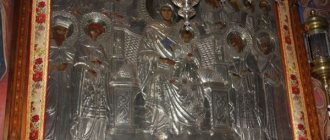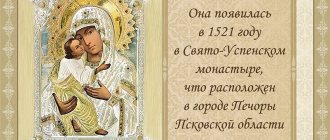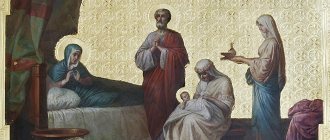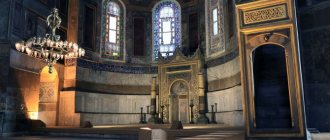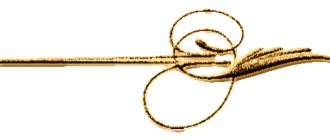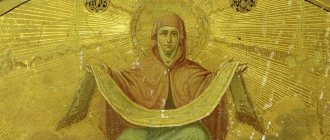There are countless icons of the Mother of God. And each was revealed precisely at the time when it was necessary, and precisely to those people who, more than anyone else, needed the help of the Queen of Heaven.
Several centuries ago, the residents of Chernigov, together with the inhabitants of the local monastery, felt the patronage of the Mother of God. The source of this patronage was the Ilyinskaya (Chernigov) icon of the Mother of God. The celebration of this holy image in the Orthodox Church takes place today - April 29.
Where did the icon come from?
The image appeared in the Chernigov province in 1658 through the works of the icon painter Grigory Dubensky. Probably a layman, and tonsured monk Gennady, painted an icon for the Trinity-Ilya Monastery, because at the time of the miracle the icon was in one of its churches.
The miracle itself happened four years after the appearance of the image. In 1662, Archbishop of Chernigov Lazar (Baranovich), abbot of the monastery Zosima, brethren and residents from all over the area found the icon “tear-stained”. According to legend, the shrine shed tears for eight days - from April 16 to April 24. Even then, it was clear to believers that this was a terrible omen, something terrible and tragic was coming.
What exactly happened?
In the same year - 1662 - the Tatars attacked Chernigov. The foreigners did not spare anything or anyone: they smashed and burned houses, killed people. They prepared the same fate for the Trinity-Ilya monastery and its brethren. However, an unknown force did not allow them to desecrate the holy place by shedding blood. The invaders threw down holy images from the walls, stole precious utensils, but they were never able to approach the newly painted icon with rich decorations. The icon remained unharmed. Like the inhabitants who hid in the cave of St. Anthony of Pechersk.
What gift did the icon receive?
For the miraculous warning and for saving the monastery, the monks and laity decided to thank the Mother of God. Of course, having just recovered from the raid, they did not have the means to present their Protectress with a particularly expensive gift, but they did not skimp on sincere gratitude, tearful prayer from the heart, and brotherly love.
Only towards the end of the 17th century, with the blessing of Bishop Lazar and donations from the hetman of the Zaporozhye army, Ivan Mazepa, was it finally possible to make a silver frame and icon case. Another philanthropist, Chernigov Colonel Vasily Dunin-Borkovsky, presented the icon with a crown with precious stones. Around the same period, residents of Chernigov ordered a new beautiful frame from Moscow.
Troparion, tone 5
Most Pure Lady Theotokos,/ the hope of all Christians,/ beyond any other hope are imams, except You,/ my All-immaculate Lady, Lady Theotokos,/ Mother of Christ my God,/ thus have mercy and deliver me from all my evils, / and beseech the merciful Son Yours and my God,/ may He have mercy on my damned soul/ and may He deliver me from eternal torment// and make me worthy of His Kingdom.
Translation: Most Pure Lady Theotokos, the hope of all Christians, since we have no other hope but You, my All-Immaculate Lady, Lady Theotokos, Mother of Christ my God, therefore have mercy and deliver me from all my troubles, and implore Thy merciful Son and my God, may he have mercy on my unfortunate soul and may he deliver me from eternal torment and make me worthy of his kingdom.
( 4 ratings, average: 5.00 out of 5)
How did the icon travel?
The icon moved first around the monastery, and then went beyond its borders. Before the appearance of the Trinity Cathedral on its territory (1679-1695), the image of the Mother of God stayed in the St. Elias Church near the caves. Later, towards the end of the 18th century, it - in a gilded silver frame, with a silver crown and precious stones - ended up in the Assumption Cathedral of the Yelets Monastery. True, then, in 1794, he returned to the Trinity-Ilyinsky monastery.
What happened to the image next is a mystery. What is known is that after the closure of the Ilyinsky Monastery in 1962, the icon again left its boundaries and “settled” with the nun Agnia, and in the mid-90s it moved to the Yeletsky Monastery that was in operation at that time.
Where is the original?
Since the fate of the icon is not known to us, it is difficult to answer this question. There are two opinions. First, the original is lost, and in the Yelets Dormition Convent, only a copy of the ancient icon is kept.
Secondly, the icon presented as a copy is the original of the Ilyinsky-Chernigov image.
Speaking of lists, they were distributed to many monasteries in Russia and Ukraine. One of them is especially revered in the Gethsemane monastery of the Trinity-Sergius Lavra. It is called the Chernigov-Gethsemane image. This is another icon; it is celebrated on September 1st.
Story
In the 40s of the 19th century, the holy fool Filippushka was known in Moscow. He was a perspicacious man and predicted many things to people. Filippushka's parents are simple peasants from the Vladimir region. At home, he got married and had two children. But he saw the meaning of his life in serving God.
One day he left his family and went on a journey. I walked around (just think that I walked!) many cities. He practically did not eat, wore chains (metal shackles) and an iron staff weighing approximately 16 kilograms. The most vivid impression he had on this journey was from the caves of the Kiev Pechersk Lavra.
After many years of wandering, Philippushka came to the Holy Trinity Sergius Lavra. He lived at the monastery for some time, and then asked permission to dig, as he said, a “cellar” not far from it. No one began to prohibit it, and the holy fool dug... not a cellar at all, but a cell for himself. Other monks learned about the secluded place for prayer and supported Philippushka. Caves for hermits appeared - similar to those that the holy fool saw in Kyiv, and then an underground church. This is how the history of the Gethsemane monastery began.
The vicar of the Holy Trinity Sergius Lavra at that time was Archimandrite Anthony, godson of Seraphim of Sarov. He presented the new church with an icon of Our Lady of Chernigov, which is where the name of this place came from. It became clear that pilgrims would come here, and the church needed a rector.
Since the 1990s, the Gethsemane Chernigov monastery has been a metochion of the Trinity-Sergius Lavra. Photo: Ivan MAKEEV
In 1851, Father Barnabas served at the Lavra. He was only 20 years old then. Father Anthony respected his opinion, despite his youth, and therefore reacted with understanding when Father Barnabas asked to be released to a quieter place - the Gethsemane monastery. This is how the first governor appeared here.
They trusted the monk and went to him for advice. Even Emperor Nicholas II came. Unlike today, women were not allowed to enter the territory.
The Gethsemane Chernigov monastery expanded. They built a ground church (originally it was wooden), then a bell tower. During the Soviet years, like most churches, the monastery was closed. They began to bring prisoners: in the 20s of the last century a prison was created here. Later there was a home for the disabled, and then warehouses.
Little remains of the 19th century buildings today. During Soviet times, the caves were filled with water, and the collapsed ceilings had to be restored. Today, two churches, a chapel and cells are open to tourists - all of them are connected by underground passages.
Why is the image interesting?
At first glance, it may seem like practically nothing. The image is written in accordance with the iconographic type called Hodegetria (Guide). On it are Those We Love. Mother of God and Christ.
The Little Lord sits on the left hand of the Virgin Mary, holding a scroll and blessing those praying. The Mother of God herself points to the Son with her hand, Her head is slightly tilted towards Him.
As for the features, they still exist.
Firstly, the figure of the Mother of God has an almost half-length edge. This image is typical for the southern and western Russian iconography of the Mother of God of the 17th century.
Secondly, you can notice that Christ seems to extend a blessing hand forward. Similar or similar compositional solutions are characteristic of other miraculous images of the Virgin Mary, which are geographically connected with Belarus and Ukraine. You can trace this connection by looking at the icons of the Mother of God: “Borkolabovskaya”, “Trigorskaya”, “Poddubetskaya”, “Gerbovetskaya”.
Thirdly, in some cases crowns can be found on the heads of both the Virgin Mary and the Lord. In general, the royal headdress is not uncommon for icons of the Mother of God, but for the Ilinsk-Chernigov icon this is the exception that has become the rule. And that's why. There are no crowns on the original. For the first time they appeared separately, on top of the icon itself, on the frame. Crowns became established in iconography thanks to the author of the 1683 engraving, made for the book of St. Demetrius of Rostov “Irrigated Fleece.”
It is noteworthy that at the turn of the 17th-18th centuries a special edition appeared in Moscow - it quite accurately repeats the miraculous icon of the Trinity-Ilinsky Monastery and its first silver frame.
The upper and side fields of the frame contain allegorical compositions, where the Mother of God is likened to fruitful trees: olive, cedar, palm, cypress.
But the contents of the lower field differ from the original. It has been deliberately changed. If the original frame depicted the coat of arms of Hetman Mazepa, flanked by a military camp illuminated by the moon and a city bathed in the sun, then in the Moscow version there was a Russian coat of arms with the image of the Azov Icon of the Mother of God. On the left is a plan of military operations in Azov, on the right is a panorama of the Trinity-Ilyinsky monastery.
ILYINSKAYA CHERNIGOV ICON OF THE MOTHER OF GOD
I. Ch. and., made in the end. XVII-XVIII centuries, were in all churches of Chernigov.
Ilyinskaya Chernigov Icon of the Mother of God. Con. XVIII century (Eletsky Assumption Monastery in Chernigov) Ilyinskaya Chernigov Icon of the Mother of God. Con. XVIII century (Eletsky Assumption Monastery in Chernigov)
Currently time in the Yeletsky Assumption Monastery in Chernigov, 2 lists are venerated. The first (late 18th century) corresponds to the size of the miraculous image and comes from the Trinity-Ilyinsky Monastery, where it was located from the beginning of the Great Patriotic War until the closure of the monastery in 1962 (during this period the monastery was for women) . From the day it was closed, the image was kept by Mon. Agnia, who transferred him to the Yelets Monastery after his rebirth in the monastery of monastic life. In 1996, the icon was restored by R. M. Bogolyub. In mon-re, the image is considered the original letter of the mon. Gennady (Dubensky), despite the iconographic discrepancy with the miraculous icon, whose image without frame is recorded in the photograph of the beginning. XX century It is possible that this icon was a copy that was placed in the Trinity Cathedral of the Trinity-Ilyinsky Monastery in the winter in place of the miraculous image. Dr. icon (19th century), smaller in size, decorated with a silver frame of the 19th century. She was in the monastery until its closure at the beginning. 20s XX century, then kept by a Kyiv nun, who in 1988 handed it over to the abbot of the Kiev Pechersk Lavra, Bishop. Jonathan. Since 1994, the image has been in the monastery; it can be identified with the beginning mentioned in the literature. XX century list of I.Ch. and. in a silver chasuble, made at the expense of the maiden Claudia.
Ilyinskaya Chernigov Icon of the Mother of God. Beginning XVIII century (Century of the Robe Deposition on Donskoy Street, Moscow)
Ilyinskaya Chernigov Icon of the Mother of God. Beginning XVIII century (Century of the Robe Deposition on Donskoy Street, Moscow)
In Gamaleevsky Kharlampiev female. The monastery housed a locally revered list (late 17th century - 1st half of the 18th century, not preserved) made for this monastery. He survived the devastating fire of the horse. XVIII century, had a silver robe (Filaret (Gumilevsky), Archbishop of the Gamaleevsky Kharlampiev Convent. Chernigov, 1862. P. 42).
In c. apostles Peter and Paul c. Repki (Gorodnyansky district, Chernigov province) there was one of the early copies (until 1742; not preserved) of the miraculous image. Initially, the icon was in the Trinity Church. (1742). description of the Chernigov diocese. Chernigov, 1874. Book 6. P. 227).
In the Voskresenskaya Church. in the town of Sosnitsa, Chernigov province. a list was supplied (not preserved), made in 1774 by order of the deacon. Jacob Berezhny. The order was obviously associated with the memory of the healings at the end. XVII century from I.Ch. and. residents of Sosnitsa Agafya Ulasova and Ioann Andreevich, which was described by St. Demetrius of Rostov in “The Irrigated Fleece.” The image was decorated with a silver gilded chasuble and had a poetic inscription.
Ilyinskaya Chernigov Icon of the Mother of God. Engraving from the book. St. Dimitri Rostovsky "Irrigated fleece". Chernigov, 1683 (State Historical Museum)
Ilyinskaya Chernigov Icon of the Mother of God. Engraving from the book. St. Dimitri Rostovsky "Irrigated fleece". Chernigov, 1683 (State Historical Museum)
In c. in the name of St. Peter, Metropolitan Moskovsky, in Ulyanka in St. Petersburg there was a list (not preserved), made, as it was believed, in the Trinity-Ilyinsky Monastery in 1696 and donated by its abbot. Lavrentiy (Krschanovich) imp. Peter I after the Azov campaign (Sakharov. 1851; Monastyrsky. 1880; Chernevsky. 1884; Karpinsky. 1913). There was an opinion that it was originally located in the Assumption Cathedral of the Moscow Kremlin, from where in 1708, along with certain items of temple utensils, it was transported to St. Petersburg to a newly built church. in the name of St. Petra. The history of the temple can be reliably traced only from 1722. The image was painted in oil in Southern Russian. manner (182.24 × 111.13 cm), its composition corresponded to the composition of the miraculous I. Ch. and. in a picture frame. The image of the Mother of God with the Child was complemented by stamps on the upper and side margins; on the lower margin there were allegorical scenes glorifying the emperor. Peter I, and 2 lengthy inscriptions-offerings. The icon was decorated with a silver chasuble with precious stones, made at the turn of the 18th and 19th centuries.
Ilyinskaya Chernigov Icon of the Mother of God. Con. XIX - early XX century Icon painter schiigum. Herman (Gomzin) (Ascension Monastery of Olives in Jerusalem)
Ilyinskaya Chernigov Icon of the Mother of God. Con. XIX - early XX century Icon painter schiigum. Herman (Gomzin) (Ascension Monastery of Olives in Jerusalem)
The origin and dating of the list (not preserved) from the Resurrection Cathedral of Smolny Monastery are unknown. The icon was discovered in the 50s. XIX century in the warehouse of old church things of the monastery and placed in the cathedral by order of its rector N.F. Raevsky. Perhaps the icon originally belonged to one of the nuns of the monastery and after her death it entered the monastery church in the name of Equal Apostles. Mary Magdalene, after the abolition of the monastery (1835) was transferred to the cathedral. Found in 19th century literature. identification of this image with the icon donated by the emperor. Peter I in 1696 and transferred to the emperor. Elizaveta Petrovna mon-rue, has no reason. The dimensions of the icon list are smaller than the original dimensions (71.12×49 cm), the iconographies differ from each other: the list does not contain an image of a frame with additional scenes and texts. At the time of glorification, the image did not have a robe or crowns. The circumstances surrounding the glorification of the icon are unclear. A version is reflected in popular literature, according to which the icon was found on June 18, 1851, according to the description of a certain guards non-commissioned officer, to whom the image appeared in a dream. With the permission of St. Petersburg Metropolitan. Nikanor (Klementyevsky), the acquired image was placed in the cathedral near the right pillar, and prayer services were served in front of it. It soon became the most revered icon in the cathedral; it was enclosed in a gilded frame and decorated with a gilded silver frame with precious stones. In 1891, a gilded icon case was built for the icon in memory of the miraculous salvation of the emperor. Alexander III and his family 17 Oct. 1888 Since 1892, on the Feast of the Transfiguration, the icon was carried in processions around local factories. Several things have been recorded from the image. miracles: through prayers in front of the icon, the cabman's yard, which belonged to the merchant's widow A. G. Prokofieva, escaped fire; former Sister of Mercy A.A. Korobova was healed of an eye disease; wife of a peasant of Tver province. O. Arsenyeva November 21 In 1901, she was cured of the disease, which she suffered for 6 years (Obraztsov. 1873; Borovsky. 1900; Nikiforovsky. 1914).
In Gethsemane in honor of the Chernigov Icon of the Mother of God, a list of I. Ch. and. (93.35 × 66.68 cm), the history of which can be traced from the beginning. XIX century He was in the house of the clergyman Khotkovsky in honor of the Intercession of the Most Holy Theotokos of the convent of St. Ivan Alekseev, who received the icon from one of the TSL monks. In 1826, the priest blessed the girl Alexandra Grigorievna Filippova, who lived in his house, with this icon, who later decided to transfer the image to the temple. With the blessing of the TSL governor, the icon was placed in the cave temple of Arch. Michael in the Gethsemane monastery, an exact list was made for Filippova, which she bequeathed to the church of the House of Charity at TSL. The first miracle from the icon - the healing of the peasant woman Fekla Elchishcheva from relaxation - occurred on September 1. 1869. In total, approx. 100 healings, the image was widely revered in Russia. Due to the influx of thousands of pilgrims into the monastery, a cathedral with a main altar was built in honor of I. Ch. (1886-1897, consecrated in 1893), where a copy of the miraculous image was placed. Before the miraculous icon was transferred to the monastery, a silver gilded crown with precious stones and a diamond clasp were made for it. In 1870, at the expense of Prince. G.I. Gruzinsky, whose daughter was healed of a fever thanks to the icon, A.M. Postnikov made a silver setting. The brocade hanging shroud to the icon and the velvet air were donated in 1874 to the widow Anna Sergeeva Kokareva, who was healed of aching bones after praying in front of the icon. Dozens of lamps from pilgrims hung in front of the icon. Many copies were made from the icon, some of them also became famous for their miracles. Most of these lists were created in the monastery of the schema. German (Gomzin). Icons of his work were in St. Petersburg, Saratov, Chernigov, in the chapel of St. Sergius of Radonezh at the Ilyinsky Gate in Moscow, Jerusalem, and Mount Athos. Until 1922, the icon remained in the monastery, then it was transferred to the church. in the name of St. Sergius of Radonezh in Rogozhskaya Sloboda in Moscow. After the closure of the temple in 1938, its fate is unknown. 3 copies of the icon were kept in TSL: in the vestibule of the Trinity Cathedral (previously standing in the church in honor of I. Ch. in the monastery), in the refectory church. St. Sergius of Radonezh and in the monastery refectory (with additional images of the upcoming St. Basil the Great and the sage Antipas of Pergamon). 13 Sep. In 2004, the first of the mentioned lists was returned to the monastery.
Ilyinsky Chernigov Icon of the Mother of God. Beginning XVIII century (collection of V. E. Bolshakov, Moscow)
Ilyinsky Chernigov Icon of the Mother of God. Beginning XVIII century (collection of V. E. Bolshakov, Moscow)
In Uspensky women. Mon-re in Perm there was an exact list (not preserved) of the image from the Gethsemane monastery. It was written in TSL in 1874 for the newly established wives. community in Perm, transformed into a monastery in 1881 (Seraphim (Kuznetsov), abbot of the Perm Assumption first-class women's dormitory monastery (in the Perm diocese). N. Novg., 1913. P. 25). The initiator of the transfer of the icon was the rector of the Kazan church built in 1873 (1st monastery building), priest. Grigory Ostroumov; funds for painting the icon were allocated by the monastery’s benefactors, the merchant brothers Fyodor and Grigory Kamensky. In 1875, the icon was decorated with gilded silver crowns with stones. Before this locally revered image, prayer services with blessing of water and an akathist were often served.
In the Russian Ascension Monastery of Olives in Jerusalem there is probably a copy of the icon from the Gethsemane monastery by the schema-abbot. German (Gomzin), brought to the Russian monastery. pilgrims in the beginning XX century At first, the icon was placed in the altar of the unfinished refectory. in the name of St. Philaret of the Merciful was then transferred to the cathedral and placed in the icon case on the right in front of the iconostasis. Soon the icon began to enjoy special veneration: every morning and evening the sisters of the monastery pray in front of it. In the monastery, the image received the local name “Quick of Olives.” Precious crowns for the icon were made at the expense of the monastery; the image was decorated with numerous gifts in gratitude for the help. All R. 80s XX century all the precious decorations and appendages to the icon were stolen (Veselkina T. Seven days on the Mount of Olives // Russian Inok. 2007. No. 57(220) (Electronic resource: www.russian-inok.org)).
In c. In the name of the Twelve Apostles, in the Moscow Kremlin there was an image mentioned in the literature of the 2nd half. XIX - early XX century (eg: Church of the Twelve Apostles and the Patriarchal, now Synodal House. M., 1869. P. 5) as completed for Patriarch Nikon in 1658 simultaneously with I.Ch. and. in Chernigov. However, historical information confirming this version has not been found (in particular, the icon is not mentioned in the description of this temple by I.M. Snegirev: Snegirev I.M. Monuments of Moscow Antiquity. M., 1842-1845).
How does prayer in front of this icon help?
In the Orthodox tradition, it is not customary to give saints responsibility for well-being in one or another sphere of life. The Lord, the Mother of God, the saints of God hear each and every one, answer, if it is useful, any request. And the Ilyinsk-Chernigov Icon of the Mother of God is confirmation of this.
Saint Demetrius of Rostov in his works “The Miracles of the Most Holy and Blessed Virgin Mary” (Novgorod-Seversky, 1677) and “The Irrigated Fleece” (Chernigov, 1683) wrote that through prayers at this image a variety of miracles happened. Mostly, these were numerous healings from ailments. Again - very different.
By turning to the Mother of God, people who suffered from blindness, leg diseases, rheumatism, relaxation, demonic possession, mental confusion, chronic diseases, paralysis and smallpox recovered. The saint wrote that through this icon the Mother of God saves even from sudden death.
“The end of the book, but not the miracles of the Most Holy Theotokos: who can count me out?” wrote the saint, thus summing up his literary work and pointing to the inexhaustible mercy of the Mother of God.
The Power of Prayer
One of the greatest weapons God has given the church is the power of prayer.
Scripture reminds us, “It is appointed for one man or woman to die, and they will be judged.” Today, all kinds of sins abound everywhere. God will forgive sin if we repent, despising such actions:
- Lies.
- Greed.
- Lack of compassion.
- Child abuse.
- Ruthlessness.
Sin spreads like a plague. There is no responsibility or discipline.
In salvation or redemption, Jesus brought to mankind the power to free people from sin. When the church spreads it throughout the world as Jesus commanded, sin will be forgiven and cleansed by the power of his blood. Sinners are set free no matter what sin they committed. When there is prayer in the church, salvation is again spread throughout the world.
Only the power of God can change the human heart and open the way to light.
The rise of the Christian faith was a turbulent time for the church. Many obstacles arose on the way of believers. King Herod, ruling Rome at this time, killed James, one of the apostles. The next day, to please the people, he put Peter in prison.
The Angel of the Lord entered the casemate and freed Peter. The prayer for salvation was answered, and God came in and brought Peter right to the door where the church prayed for him. God has proven that he is in control. He, not kings or political leaders.
Therefore, Christians must remember the need to communicate with the Lord, thank him for every day of their lives and ask for help. Then sincere requests will definitely reach the ears of the Creator.
